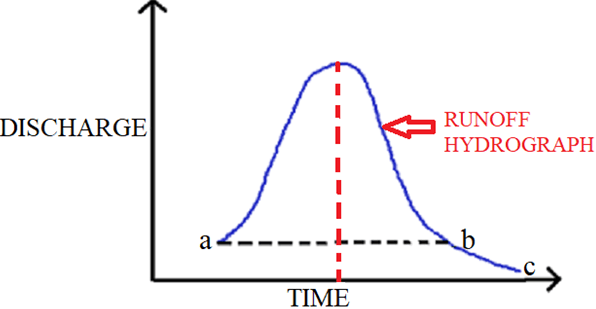This set of Engineering Hydrology Multiple Choice Questions & Answers (MCQs) focuses on “Direct Runoff Hydrograph”.
1. What is direct runoff hydrograph?
a) Drainage hydrograph
b) Base flow hydrograph
c) River surface runoff hydrograph
d) Groundwater depletion curve
View Answer
Explanation: When the groundwater inflow which is supplied to the river is deducted from total discharge of the river then river surface runoff is obtained. The river surface runoff hydrograph is called direct runoff hydrograph.
2. Based on which assumption, the direct runoff hydrograph is obtained from groundwater inflow?
a) The total groundwater flows into the river
b) The direct precipitation is converted to baseflow only
c) The direct precipitation is converted to surface runoff only
d) The direct precipitation over the river is ignored
View Answer
Explanation: The direct runoff hydrograph is the surface runoff flowing into the river. So, the direct runoff hydrograph is obtained when groundwater flowing into the river is deducted from the total discharge of the river. This calculation can only be done considering an assumption that is the direct precipitation over the river is ignored.
3. Which of the following gives the direct runoff hydrograph?
a) Area enclosed between total drainage and surface runoff
b) Area enclosed between runoff hydrograph and groundwater inflow curve
c) Area enclosed between groundwater inflow curve and surface runoff
d) Area enclosed between direct precipitation curve and runoff hydrograph
View Answer
Explanation: In order to obtain the surface runoff hydrograph, the ground water inflow curve is superimposed over the runoff hydrograph. The area enclosed between the runoff hydrograph and ground water depletion curve gives the surface runoff hydrograph that is the direct runoff hydrograph (DRH).
4. The following figure depicts runoff hydrograph of a river. What does the line “ab” represent?

a) Assumed surface runoff
b) Assumed ground water inflow
c) Assumed river discharge
d) Assumed precipitation over river
View Answer
Explanation: In order to determine the direct runoff hydrograph, the ground water depletion curve is superimposed over the river runoff hydrograph. So, the baseflow is separated by drawing a line “ab” in river runoff hydrograph. The line “ab” represents the assumed ground water inflow or baseflow.
5. The following figure represents the runoff hydrograph of a river. What does line “bc” represent?

a) Surface runoff
b) Drainage of river
c) Direct runoff curve
d) Groundwater depletion curve
View Answer
Explanation: The baseflow is separated from the river runoff hydrograph to obtain direct runoff hydrograph. Line “ab” represents the assumed ground water inflow where “b” represents the point where surface runoff ceases. Therefore, below point “b” that is line “bc” represents the groundwater depletion curve.
6. Which of the following is not a type of stream?
a) Intermittent stream
b) Perennial streams
c) Premeal streams
d) Ephemeral streams
View Answer
Explanation: The streams are classified into three types to determine the annual hydrograph of the streams properly. The three types of streams are as follows:
i) Intermittent streams
ii) Perennial streams
iii) Ephemeral streams
7. Perennial streams carry flow for which time period?
a) Throughout the year
b) During monsoons only
c) During summer and monsoons
d) During winter only
View Answer
Explanation: Perennial streams are those streams which carry flow throughout the year. So, some amount of water is supplied to such streams from snowmelts and also from baseflow.
8. Which of the following river is a perennial stream?
a) Kaveri
b) Teesta
c) Yamuna
d) Brahmaputra
View Answer
Explanation: Perennial rivers carry flow throughout the year. They carry water from melting of snow as well as baseflow when the groundwater table is above the level of the water level of the river. Examples of perennial streams are Brahmaputra and Ganga.
9. Which of the following type of streams carries flow only due to getting supply from baseflow?
a) Perennial stream
b) Intermittent stream
c) Ephemeral streams
d) Annual stream
View Answer
Explanation: Intermittent steams receive water from baseflow only. So, when the water table is above the level of river water then only water is supplied to the perennial streams.
10. Intermittent streams carry flow during which period of time?
a) During winter
b) During summer
c) Throughout the year
d) During monsoons
View Answer
Explanation: Intermittent streams carry flow only during monsoons. Intermittent streams receive water only from baseflow. During monsoons, the ground water table moves above the water level of river and at that time groundwater flows into the river.
11. Which type of stream depicts a hydrograph only due to rain storms?
a) Perennial stream
b) Intermittent stream
c) Ephemeral streams
d) Annual stream
View Answer
Explanation: Ephemeral streams receive water only from rain storms. So, the hydrograph depicts flash flows due to rain storms only. The river Luni is an example of such type of streams.
12. Which of the following stream does not receive any supply of water from baseflow?
a) Perennial stream
b) Intermittent stream
c) Ephemeral streams
d) Annual stream
View Answer
Explanation: Ephemeral streams do not receive water from baseflow. The ground water table in such areas is always below the river water level. Such streams receive water from rain storms only.
Sanfoundry Global Education & Learning Series – Engineering Hydrology.
To practice all areas of Engineering Hydrology, here is complete set of 1000+ Multiple Choice Questions and Answers.
If you find a mistake in question / option / answer, kindly take a screenshot and email to [email protected]
